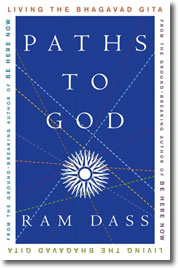Paths to God: Living the Bhagavad Gita
by Ram Dass
Harmony, 2005
I first read the Bhagavad Gita as part of background research for my senior college thesis on T.S. Eliot’s “Four Quartets.” Although it’s been more than 200 years since the Gita was translated into English by Sir Charles Wilkins and printed by the East India Company of London, it remains relatively unknown in the English speaking world. Part of the problem is that, unlike the New Testament or the Koran, there is no rule in the Gita that advises followers to spread its teachings. In addition, while English translations remain easily accessible, it’s more difficult to find a good commentary or teacher to guide you through the text. Thankfully, with the publication of Paths to God, we now have just that.
We learn in the introduction that Paths to God began as a set of lectures given by Ram Dass during a month-long summer program at the Naropa Institute in 1974. Naropa, now a fully accredited university, was just getting started in those days. From the photos, we get a glimpse of Naropa as Woodstock-like setting replete with peasant-clad hippies. Ram Dass himself wore the long beard of a guru and had the beginnings of a Buddha belly. The curriculum included full immersion in Eastern religious practices, including chanting and meditation, rounded out by lectures by Ram Dass and Naropa founder Chogyam Trungpa.
Kudos go to Ram Dass and the members of his team for their fine job of reducing what must have been a massive amount of acetate into book form. At the outset, Ram Dass recommends a three-stage process of familiarizing oneself with the Gita.He advises first reading the Gita straight through, then reading his book, and then reading the Gita for a second time. Readers should be warned that Paths to God includes very little summary of the sacred text. The author assumes the reader has familiarity with the plot and characters of the Gita. In my opinion, this is more a virtue than a weakness for it frees Ram Dass up to deal with the spiritual issues it raises.
The basic theme of the Gita is human emancipation. According to Ram Dass, the Gita is organized like a spiral staircase leading the soul toward the divine light. From the first stage, which is understanding the human predicament, to the final stage, which is complete detachment from earthly desires and acceptance of the Divine Will, the Gita both describes the various stages of enlightenment and provides the means for attaining that goal. It’s Ram Dass’ handling of this latter element which makes this book so useful. Most other commentaries on the Gita stop short of exploring its practical side and showing readers how it can be used as a spiritual manual.
Ram Dass spends a good deal of time explaining the basic Hindu teachings on reincarnation. For me, this was the most valuable aspect of the book. Steeped as I am in Judeo-Christian understanding of the soul, I’ve never come across a more reasonable and more attractive explanation for belief in reincarnation than found here. Ram Dass has a wonderful way of using anecdotes to illustrate deep teachings and he brings all of his gifts as teacher to bear on this esoteric topic.
One shortcoming I
would have liked addressed, however, is the book’s lack of background on Ram
Dass’ own study of Hindusim. For example, there are many foreign terms sprinkled
throughout the book, all of which are clearly and elegantly explained, but it
would have been helpful to know how and where he came to possess such knowledge.
Despite giving us many personal anecdotes of meeting with this Indian guru and
hanging out with that Zen master, we’re left with the suspicion that Ram Dass is
a man of great curiosity and intuition, but little formal schooling. Readers
accustomed to having several initials after the names of their spiritual guides
may feel a little uncomfortable with this.
Copyright ©2005
John Tintera
Help explorefaith.org. Purchase a copy of PATHS OF GOD by following this link to amazon.com.
